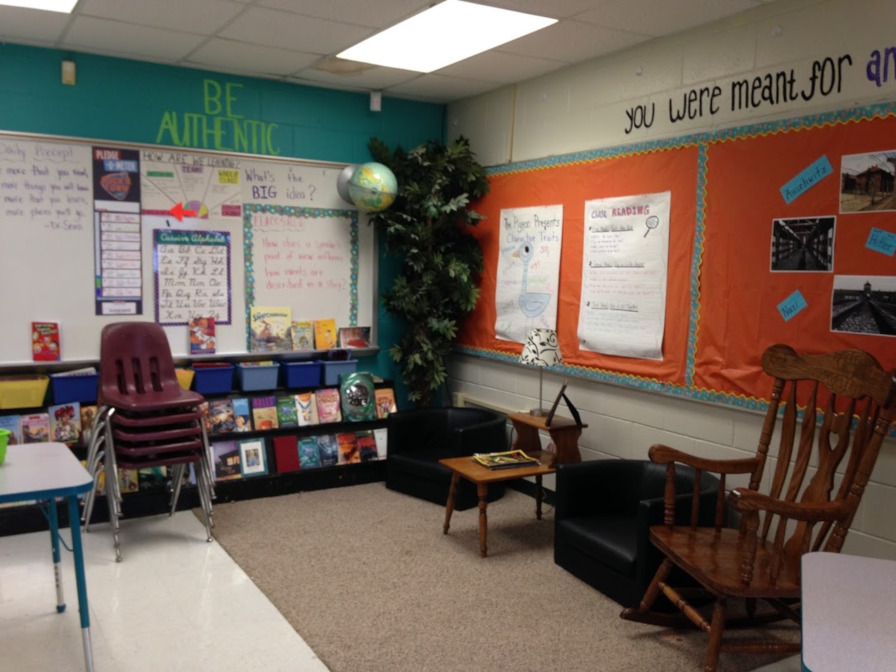As writing teachers, we all want to support students in becoming capable writers who can communicate their ideas but we also want so much more. We want students to become powerful writers who can explore and impact the world with their words. We want them to use their writing to discover new ideas, to inquire about fairness and justice, and to propel their voices to make a difference in many different ways.
But how do we make our classrooms places where this magic can start happening?
We like to start with two key questions to get started:
1) What does it mean to create a physical space for powerful writers and writing?
2) What does it mean to create an intellectually and emotionally safe space that encourages and supports powerful writers and writing?
The physical space, supplies, and materials matter to young writers too.
Think about your own needs as a writer:
1. What types of materials do you like to have nearby? Lots of paper, staplers, markers, scissors, glue, pens, pencils?
2. Do you enjoy writing in a comfortable chair, on the floor, or is a desk better?
3. Is it important to have books, pictures, or a device nearby to look things up, get inspiration, find ideas?
4. Do you like silence or quiet background noise?
5. How and why do you move between writing on devices (phones, laptops) and writing on paper?
6. How does lighting affect you? Do you like fluorescent lighting, several lamps? Natural light? A candle?
7. Do you like sitting at a group with other writers or tucked away in a quiet corner?
Considering these questions about ourselves as writers can help us tune in to the physical environments we create for our student writers. Of course we need to remember that everyone has different preferences, so if someone needs silence while others like quiet music, that writer might write with headphones on to block out any noise. But creating a physical space with various grouping/seating options, places where supplies and materials are easy to get to, where the lighting and sounds help to set a mood, and young writers have plenty of time to write is the way to get started.
Powerful writers need intellectually and emotionally supportive spaces
This is another aspect of our classroom where it helps if teachers think about themselves and what they really need to take risks, be bold, and risk looking silly or ignorant in front of one’s peers. Writing about “rainbows and unicorns” topics can make a writer feel much less vulnerable than writing about topics that matter most in the moment such as a family not having enough money to pay the bills, a parent having a terminal illness, a heartbreak, feeling the stigma of racism, being worried about gun violence, and so many other things.

In a powerful writing space, all topics are allowed and valued (see this article, “
No Blood, Guns, or Gays Allowed!: The Silencing of the Elementary Writer,” for a discussion of how this can be difficult but necessary). That doesn’t mean that writers have the right to write pieces that incite hatred or reproduce stereotypes about people, and a skilled writing teacher will work with writers when they see this happening. It does mean, however, that a skilled writing teacher will ask the following questions as she or he plans for creating an intellectually and emotionally safe writing space:
1. How can I use circle time, morning meeting, or another time during the day to create an overall culture of hearing one another and valuing one another’s experiences and perspectives?
2. How can I facilitate a discussion if a student reacts negatively or in a judgmental way to another student and what she or he is writing?
3. In what ways can I assure student writers that their voice matters regardless of whether they are writing about rainbows and unicorns, superheroes, pets dying, or issues of mass incarceration or sexual harassment?
4. What rituals might we have in place to acknowledge and honor student writers? Will we snap after writers share? Will we have a short moment of silence in honor of a sharing? Will we hold an open mic once a month/semester to showcase writers’ work?
5. As students write about “tough topics” that are meaningful to them, what books and other materials might they need in order to gain more information and knowledge about the topic and to make their personal writing more powerful by connecting to bigger contexts?
6. How can I teach mini-lessons that demonstrate that “tough topics” are welcome and valued in my writing classroom?
7. How can I, as the teacher, model responding with curiosity rather than judgment when a student shares a story, writes a story, or talks about something that is outside of my “normal” experiences?
Creating a classroom space where students feel safe to push themselves intellectually and they can count on their classmates and teachers to be emotionally supportive isn’t a one-time lesson plan. This is about slowly and steadily building a way of being or a culture in the classroom that is about respect, honor, value, encouragement, and support of writers taking all the risks they take every day.

